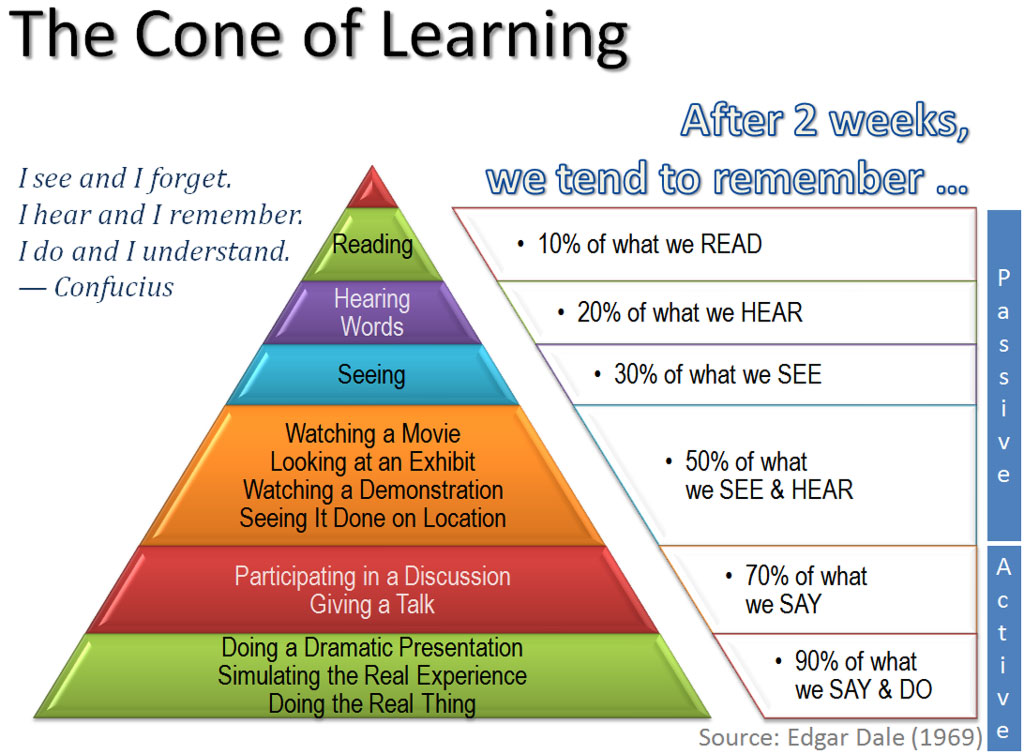Article: Active Learning
PLE - Personal Learning Environment
The best answer to the question, "What is the most effective method of teaching?" is that it depends on the goal, the student, the content, and the teacher. But the next best answer is, "students teaching other students."
Wilbert J. McKeachie - Author of Teaching tips: Strategies, research and theory for for college and university teachers, Houghton-Mifflin (1998).
Most of the time, in a typical classroom setting, students are involved only passively in learning, i.e., in listening to the instructor, looking at the occasional overhead or slide, and reading (when required) the text book. Research shows that such passive involvement generally leads to a limited retention of knowledge by students, as indicated in the 'cone of learning' shown below.
The Cone of Learning

According to Ronald A. Berk in his book "Professors are from Mars. Students are from Snickers" (Mendota Press), the only way to get 100% retention of information is by:
"...hearing, seeing, doing, smelling, feeling, tasting, inhaling, injecting and purchasing on credit..."
some of which are highly illegal in the classroom!
However, research also indicates that by re-organizing or adapting the ways they present material to students, instructors can create an environment in which knowledge retention is significantly increased; of course, such situations require the cooperation of the students themselves. One of the best methods is to implement so-called active learning.
OK, so what is active learning?
Quite simply, it is involving students directly and actively in the learning process itself. This means that instead of simply receiving information verbally and visually, students are receiving and participating and doing. The latter grouping is what is meant by active learning. So, in simple terms then, active learning is:
- engaging students in doing something besides listening to a lecture and taking notes to help them learn and apply course material. Students may be involved in talking and listening to one another, or writing, reading and reflecting individually.
A process I use a lot in the classroom is collaborative learning, which is:
- a subset of active learning activities that engage students in interacting with one another while learning and applying the course material. Usually it involves breaking the class into small groups (of 2 or 3 students) and me posing a question, often of a conceptual nature, and allowing each group to discuss a possible answer for a period of a minute or two. I then seek answers at random.
It is important to realize that students sitting in a group and studying together, or group projects in which one or two students do all the work, do not constitute active nor collaborative learning.
Instructors and students alike will want to know ... "What are the benefits of active and collaborative learning?" In addition to the obvious advantages of information retention many research studies show that there will be improvements in:
- student-faculty interaction,
- student-student interaction,
- academic achievement (i.e., grades),
- communication skills,
- higher-level thinking skills,
- teamwork,
- attitude towards the subject and motivation to learn.
The reason why it works is that:
- individual students may get stuck on a problem and give up, whereas groups of students tend to keep going, students become exposed to alternative problem-solving strategies, students are much less fearful of generating and answering questions among themselves than individually and directly to the instructor in class, and as McKeachie says, (see the quote at the top of the page), students learn best what they teach!
I am an advocate of active learning because I have used it and seen that it really does work! ... honestly!
* Adapted from R.M. Felder and R. Brent Effective Teaching Workshop, North Carolina State University, 1997.
from topic: PLE - Personal Learning Environment



